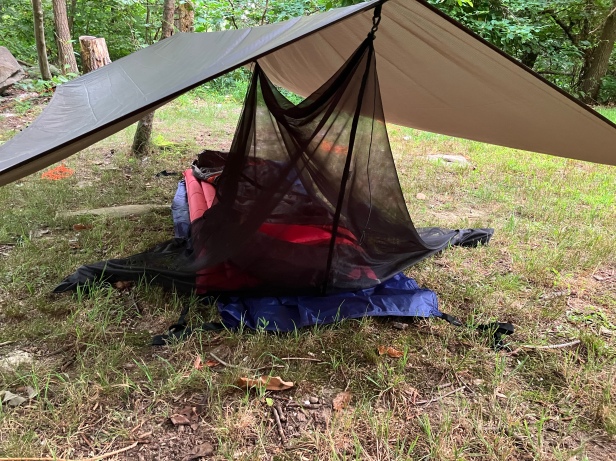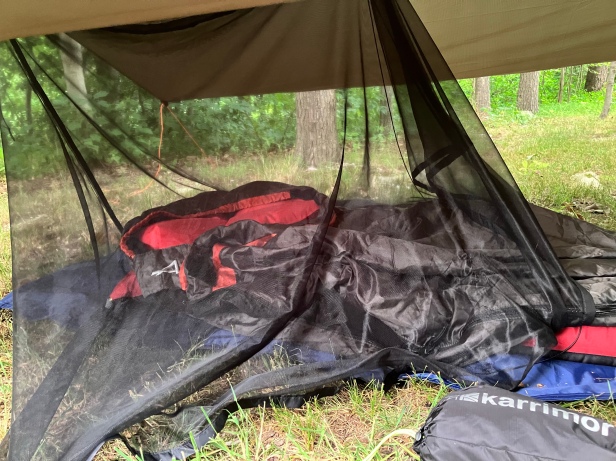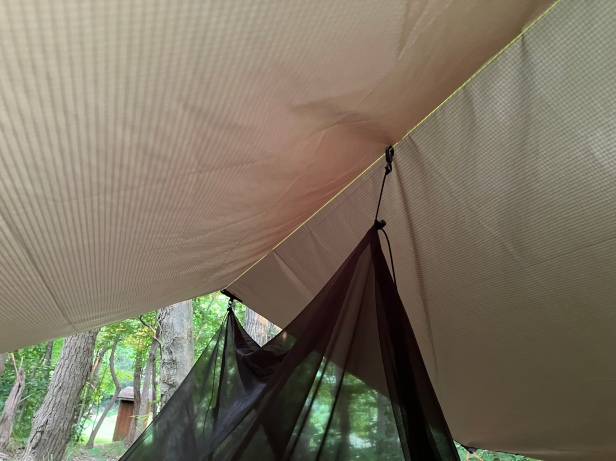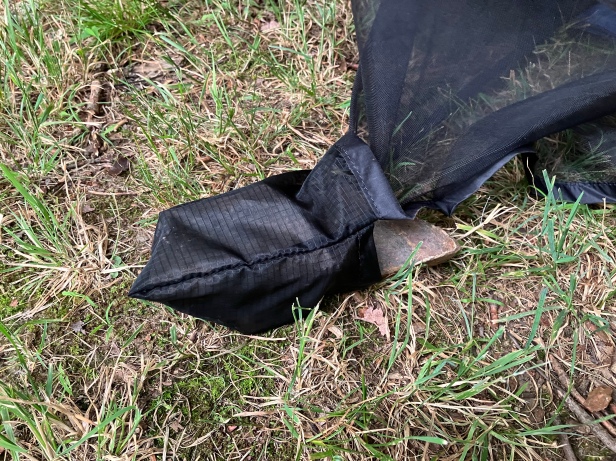In my previous post on the Borah Gear Silpoly Solo Tarp, I recapped my journey to selecting a tarp setup for backpacking over a one person tent. When you’re sleeping under a tarp, you are faced with increased exposure to bugs. Tents seal you off from bugs with zippers – tarps don’t. I needed to complete my tarp setup with some bug protection, and I landed on the YAMA Mountain Gear Bug Canopy. This product got good reviews on Reddit, and seemed to fit the ultralight bill. Once you start adding luxuries to your tarp setup (e.g. full body, zipper-enclosed bug shelters), you might as well go back to the one person tent. So in an effort to minimize my weight, I gave the Bug Canopy a shot.

I’m not afraid of bugs by any means. But I think it is human nature to be wary of bugs. Call it evolutionary instinct. In the course of my research on tarp setups, I read several horror stories that made me realize I needed to take bug protection seriously. For example, I read one anecdote by a user of the Bug Canopy who said he woke up one morning to his net covered almost entirely in wolf spiders. To the Bug Canopy’s credit, he said no bugs got into the net. But the fact that this many wolf spiders would be crawling over you without a net is next level, and highlights the need for bug protection.
First, let’s talk tech specs. This thing is ultralight. The netting, shock cords, and clips together weigh only 3.3 oz. Further, it compacts down nicely into a stuff sack so it doesn’t take up a lot of space. I use a Borah Gear 4×8″ stuff sack for this and it works perfectly. It’s lightweight and takes up minimal space – you can’t ask for much more. Further, the netting is “no-see-um” netting which means that it is fine enough to keep out the smallest of bugs such as no-see-ums. This is important because if you get an alternative product to this, you may only be getting mosquito sized netting and still have issues with no-see-ums. The Bug Canopy checks all the boxes for an ultralight and utilitarian bug net.

Once you’ve set up your tarp, you can set up the Bug Canopy by clipping it in two places to either your ridgeline or other lines if you are using trekking poles. Then you drape the netting around your sleeping pad and sleeping bag, tuck it under, then wrap the enclosing shock cord to seal the bugs out. There’s two pockets on the side to place rocks in if you choose, which helps keep the net in place. It sounds simple, but my experience was a little more challenging than I just made it sound.

It took me a while to realize that the success in sealing off the Bug Canopy lies in how you adjust the shock cords, namely the second shock cord that connects above your head – the one closer to your midsection. You have to adjust this shock cord so that the net will fall over your sleeping bag, otherwise you will have a gap that bugs could fly into. While maybe most users are smarter than me, I would have benefitted from some instructional content. Whether a sheet of paper with the product or a product video on the website – just anything showing how it’s supposed to be set up. This was lacking, and would have greatly improved my experience.
I’ve only used this for one night so far, but for that one night I did not set it up properly and had such a gap. It was a warm summer night in the northern Virginia Appalachians. Despite it being peak mosquito weather, I still did not have any issues with bugs as I slept. Despite the gap, the remainder of the netting did its job and kept bugs off of me so I can’t really complain. I share this experience so that you make sure to practice setting it up in advance. I did not, and for that only I am to blame.

One of the drawbacks about this product that I did not realize upon ordering it, and that the stock product photos do not make clear, is that it is not sealed off at the bottom. By that I mean, you are not fully enclosed by the netting. I assumed that the netting would go completely under my sleeping pad but it does not. Technically bugs could still crawl through this, but it is unlikely. I did not have any issues with the open bottom, but I want to make potential buyers aware of this since it caught me by surprise. Just make sure to tuck this under your sleeping setup. If you move a lot in your sleep I could see this being frustrating, but it was fine for me.
I can’t yet speak to its durability since I’ve only used it once. It seems durable but I can’t say for sure yet. I will update this post as necessary if I experience durability issues.
Lastly, I want to highlight that YAMA Mountain Gear is a cottage industry company. The owner – Gen Shimizu – founded the company inspired by his own experiences. They endeavor to minimize their impact on the environment. Their products are made right here in America in Montana. You’re supporting an American small business if you buy their products, which you can feel good about.
Pros
- Keeps bugs off
- Ultralight and compact
- Affordable
- Made in America by a small business
Cons
- Net is open on the bottom, requires tucking to keep bugs out
- Could use instructional content
Rating: 4 / 5

Overall the YAMA Mountain Gear Bug Canopy seems like a solid product. I am happy with my experience thus far, and will be testing it further when Chris and I hit the trail again this fall. I slept like a baby and no bugs bothered me in the peak of summer in the Virginia Appalachians, which is impressive. I am more experienced with this product and feel more confident setting it up than I did the first time around, but I would have benefitted from some instructional content from the company. While I think the product description could make it clearer that the netting is not fully enclosed and requires tucking, I can’t fault the product in the end because it worked regardless.
Note that YAMA also makes two other fully enclosed bug shelters, which come at an increased price and increased weight. I chose the smaller product in an effort to reduce pack weight. If you’re not quite ready to leap into a more open netting setup, you could try one of their other products and you might sleep sounder knowing the bugs definitely won’t get to you. But the Bug Canopy, in its minimalist design, works just fine and I have no regrets thus far. I look forward to many years of outings with the YAMA Mountain Gear Bug Canopy.
If you have experience with the Bug Canopy, please share your experience in the comments below. If you have other bug net products you recommend, share with our readers! I’d love to see what else is out there. Thanks for reading!

